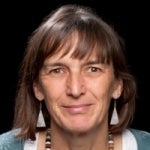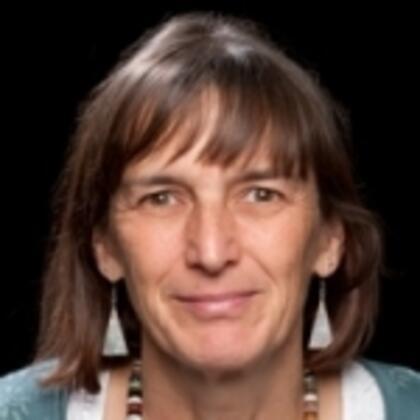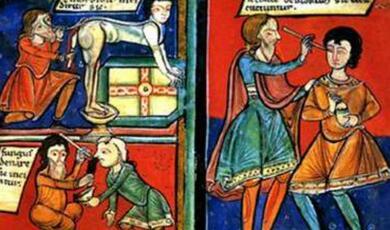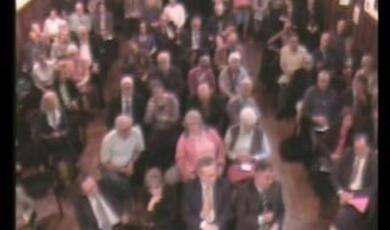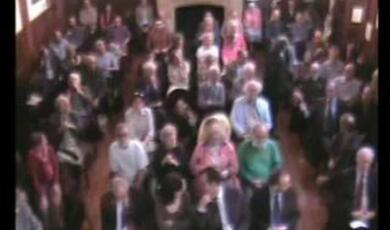The Archaeology of Disease Documented in Skeletons
Share
- Details
- Transcript
- Audio
- Downloads
- Extra Reading
Disease affects us all during our lives. This lecture will show how archaeological skeletons can inform our understanding of people's health in the past. It will focus on how this is done and why it is important, including recent research on infectious disease. It will show how the deep time perspective that we gain by analysing skeletons from different burial contexts provides us with a better understanding of who we are today.
Part of the Mondays at One Archaeology Series.
Download Transcript
26 October 2015
The Archaeology of Disease
Documented in Skeletons
Professor Charlotte Roberts
Introduction
Everybody who reads this is probably familiar with the many excavations of skeletons from archaeological sites, as seen on television and reported in the news. What we can learn from studying skeletons is changing and increasing as new methods develop and we delve, for example, into the DNA of the organisms that cause different diseases. However, let us stop and think about why studying our ancestors' remains are important to understanding our history.
The human population today shapes the world in which we live, both directly and indirectly. It is responsible for the very function of society, including contributing to developments in socioeconomic and political structures at local, national and international levels. The world's population reached 7.2 billion in mid-2015, and there are 16 "Sustainable Development Goals", many reflecting the impact of increases in the global population on health and well-being. Europe has also developed a new "Health 2020" policy, with four priority areas: invest in health and empower citizens, tackle Europe's the major disease affecting our population; strengthen people-centered health systems and public health capacity, and create supportive environments and resilient communities. In 2015 we face many challenges to keep the world's population alive, well and free from poverty, but how does this relate to the lives of our ancestors living in in the past? The human remains of these once living people also have an important story to tell, were central to how society functioned, and potentially provide us with a longer time perspective on health and well-being that perhaps can help us understand the issues we face today and plan for the future. Britain today, and in previous times, is a place that experiences constant change as global travel increases and multiculturalism becomes increasingly dominant. In the past a similar situation is found, albeit slower in development. Archaeologists are fortunate in having the opportunity to explore our ancestors' worlds through excavating their actual remains, but also a wealth of other finds.
It could be argued that the study of human remains (bioarcheology) within their cultural context, including the funerary rituals that took place at death, is the most important part of the reconstruction of past lives. Apart from natural phenomena such as earthquakes and climate change, with the consequences that they can bring to society, economy and the environment (increased deaths, crop failure, changes in weather patterns), humans have been instrumental for change throughout their history everywhere in the world. Without them, there would be no world, as we know it today. Over thousands of years, they built houses, domesticated animals and crops, made the pottery, changed their environment to suit their needs, and developed socio-cultural-economic and political infrastructures and processes; without them there would be no past to study. Therefore, they have much to tell us about their lives and how their experiences impacted the very development of their world. In this paper, and during the presentation, four pertinent areas are considered:
- The context: How the study of human skeletal remains (bioarcheology) "fits" into the discipline of archaeology
- Studying health and well-being (paleopathology): How disease affects the skeleton, and what methods are used to detect those diseases
- Research: some research projects to highlight the type of work that is done in charting our ancestors' health
- Importance of paleopathology: Why studying disease is important
The Context: How the study of human skeletal remains "fits" into the discipline of archaeology
Bioarcheology is the contextualized study of human remains from archaeological sites. In the UK it is part of the discipline of archaeology which, in its broadest sense, is "the study of people. It has become an immensely popular area of archaeological study, and many university archaeology and anthropology degrees incorporate some teaching in this field. This has not always been the case and is something that has developed over the last 30 years or so, related to the advent of masters degrees in the subject from 1990 onwards to train (mostly) archaeology and anthropology graduates in its study. In effect, it is suggested that with more masters graduates with relevant skills and knowledge to analyse and interpret archaeological human remains, and inevitably more PhD students, this has led to a greater awareness in the archaeological community of the value of excavation and analysis of human remains (commercial archaeology and in universities). It is perhaps also pertinent to suggest that with changes in how commercial archaeology operates in the UK, from 1990 onwards, more cemeteries have been excavated and more "practitioners" have been needed to excavate and analyse human remains. Ultimately academic more posts in universities in bioarcheology have been created, and so the cycle continues. Our national organization was also formed in 1998, BABAO (British Association of Biological Anthropology and Osteoarchaeology), thus supporting people working in this field.
Bioarchaeology encompasses a very broad approach to understanding how our ancestors lived, which starts with their human remains. The data collected from human remains are interpreted in relation to archaeological, and historical where appropriate, data to understand and interpret the context in which these people lived. It is important to consider the relevant information about their lives with reference to their environment (housing and wider outdoor environment, including climate), the diet they ate and the economy in which they existed, the work that they did, the level and types of trade in which they were involved, whether they were mobile locally, and more extensively, had access to care and treatment, and how they were treated in death. Of course, all these thematic aspects of people's lives come together to describe what is today described as "identity": the state of having unique identifying characteristics held by no other person or thing, or the individual characteristics by which a person or thing is recognized. This may include their biological sex, gender, age, ancestry, health "status", and also their religion, occupation, and beliefs. It is important to remember therefore that each person today is different to the next person, as they were in the past.
Bioarcheology involves a question driven, multidisciplinary, multi-method approach and increasingly involves teamwork. It mainly involves the study of skeletons - these are the most commonly found and excavated human remains anywhere in the world. Human remains are excavated form a variety of funerary contexts, ranging from prehistoric burial mounds (barrows), through cremated burials, to large urban cemeteries of the Roman period. When it comes to the late medieval period onwards (12 th century) in the UK, we are fortunate to have historical documents that help to "put flesh on the bones". For example, people in this period were inhumed in a Christian manner, on their backs (supine) and orientated with their heads to the west. There can be deviations from the normative burial; for example for Jewish cemeteries some sites tend to show some north-south orientations with skeletons with their arms by their sides, unlike the tradition of hands on the pelvis common to Christian burials Sometimes people may also have been buried prone, and have been recorded as having a pathological condition. Grave goods were sparse, and thus we lack the addition of grave goods that can provide information about a person's identity (compared to the previous early medieval period, where grave goods were relatively plentiful. However, chalices and patterns have been found, presumably reflecting religious practitioners, as has direct evidence for treatment of disease.
Prior to describing how skeletons are analysed, the ethical issues surrounding their excavation and study should be considered. Bio archaeologists consider it to be a privilege and not a right to excavate and analyse skeletons, and treat the human remains they encounter with respect and dignity; in the UK there are a plethora of guidance documents that help advise on the "proper" treatment of the remains of our once living ancestors. Human remains in the UK are almost wholly excavated in advance of new developments (e.g. new buildings such as hospitals, supermarkets, car parks etc.); survey and excavation of all detected archaeological evidence, including human remains, are required by law. Some remains are reburied immediately following excavation, some are analysed and then reburied, and some are retained for future research and may be curated in museums (as in the Museum of London) or other institutions such as universities (as at Durham). Clearly everybody has different opinions about whether excavation and analysis of human remains are acceptable, and this may be affected by religious faith. Suffice it to say, all interested parties who have opinions should be encouraged to become engaged in any dialogue regarding archaeological human remains (and listened to), from excavation to final "disposition'" whether that be in a museum for bona fide research, or reburial. However, studying our ancestors' lives provides us with a deep time perspective to understanding who we are today. If we can shape research, that contributes to living and future health, all the better.
When it comes to analysis, first, the bones and teeth preserved and excavated are recorded. Next the person's biological sex is estimated primarily through their pelvic bones. While on the face of it, this may seem a relatively straightforward task, a person's lifestyle, age and geographic location may influence the expression of the features used to estimate sex from their skeleton. For example, a coarse diet might enhance some of the skull features, making a person appear more male than female, and increasing age can lead to a more male appearance for a female's skull. However, estimating the sex of the skeleton of a person who has not reached maturity is challenging. However, ancient DNA analysis may be possible if the DNA survives burial (DNA is a self-replicating material which is present in nearly all living organisms and makes them unique - it is a carrier of genetic information, and it is the main constituent of chromosomes which are inside the nucleus of cells). Analysis is directed at the Y chromosome i.e. that which determines "maleness".
Following sex estimation, age at death is estimated, which is much more accurate for people who had not attained adulthood at the time of their deaths. The formation and eruption of the teeth, the replacement of the deciduous (milk) teeth with permanent teeth, and the development of the bones of the skeleton comprise the areas of interest for the bio archaeologist. The timing of these changes and the methods of analysis are based on relatively recent populations where documented skeletons with known age at death, and radiographs of developing teeth and bones of living people, are used alongside the analysis of the skeletal remains. It is possible for a well-preserved skeleton to be aged into quite narrow age categories. When the age of adult skeletons is estimated, the bio archaeologist considers changes in the teeth and bones that are classified as "degenerative" and related to age. However, as we all know, people's bodies degenerate at different rates for their sex and their lifestyle, but also according to their genetic predisposition. Therefore, geographic location and time period are important things to consider when considering age at death. Improving adult age at death estimation has thus become a key research area in bioarcheology. Acquiring precise age at death data from remains is a pre-requisite for attaining a representative demographic profile for any archaeological population, and currently it is only possible to assign broad age ranges for adult skeletons. Thus, complex statistical methods have been developed to improve accuracy, albeit still needing more work. However, once age and sex data have been accumulated, a demographic profile will be created that provides the relative frequency of ages at death between the age categories (adults and non-adults) and sexes (adults only).
Next, a series of standard measurements are taken of the bones and teeth, and the presence and absence of "non-metric traits". This is to enable bio archaeologists to explore "normal variation", for example differences in estimated height seen from measurements from the long bones. Frequencies of non-metric traits, particularly in the teeth, can enable "distance" to be estimated between individuals within a population, and between populations. For example, certain dental non-metric traits are more common today in some parts of the world than others. Thus it can be possible to start to think about the movement (e.g. migration) of people in the past, in combination with biomolecular analyses such as those involving stable isotopes ("chemical analysis" of teeth and bones) and mitochondrial DNA (genetic material inherited form the mother).
Studying health and well-being (paleopathology): How disease affects the skeleton, and what methods are used to detect those diseases
Once what would be called the underlying "baseline" data have been recorded, all essential for the interpretation of a person or population's health, finally, an assessment of the skeleton is made for evidence of disease (paleopathology). Bone formation and destruction, destruction of the teeth (e.g. "black holes", or caries) and supporting jaw structures (e.g. abscesses), defects in the teeth, and dental plaque are all recorded. Their distribution pattern is charted and differential diagnoses made, based on clinical/medical understanding. Differential diagnoses are the potential diseases that the bone or dental changes might represent; bearing in mind that disease can only affect the skeleton in a limited number of ways. Applying signs (what they may look like e.g. pale) and symptoms (what the person feels e.g. pain) to those who suffered specific diseases is a possible way of interpreting the impact of disease on past people, remembering that the signs and symptoms described in clinical literature may not all apply to every person with a particular disease. Diagnosing disease is not without its challenges, but paleopathologists also attempt to consider the frequency of any one disease in a population. However, they must consider how representative the "sample" of skeletons studied is when compared to the living population who contributed to the cemetery site (very difficult indeed). We are more often than not looking at a sample of a sample of a sample or the original population. They are also the dead and not those who were still living at the time of the functioning cemetery. Furthermore, the skeletons with evidence of disease are considered the healthy people, or those who survived the acute stages of a disease to develop chronic (and often healed) lesions of disease. Those with no bone changes could have died from the acute stages, or of a soft tissue disease, thus having no bone changes to observe (e.g. malaria, the plague). It may perhaps be argued that a population's health is the key to understanding past society; imagine a population struck down by the 14 th century AD plague in Europe and its impact on the very survival of society. Ill people do not function as well as when they are well.
The main categories of disease that are found using traditional methods of analysis i.e. "looking" at the bones are: diseases that people are born with (congenital), dental problems, trauma, joint disease (e.g. osteoarthritis), metabolic problems (e.g. vitamin D deficiency), infections (e.g. tuberculosis), and cancers. However, methods of analysis of skeletal remains have developed considerably over the last 30 or so years. While most scholars study skeletons "macroscopically" without any additional aids (see above), there have been increasing moves to use various radiological (X-ray) and histological (microscopic) methods to help age skeletons and diagnose disease and trauma. However, the two analytical methods that have seen much application to archaeological human remains have been stable isotope and ancient DNA analyses, both of which target biomolecules. The former has generated information about mobility and diet of past populations, and the latter about disease diagnosis, kinship and migration. These methods are allowing bio archaeologists to generate much more nuanced data about the past and answer complex questions using trans-disciplinary approaches, albeit involving what can be expensive destructive analyses. While all these methods are exciting and innovative it should be remembered that it is essential to collect the baseline data before any destructive analyses are performed (age at death, biological sex, normal – metrical and non-metrical, and abnormal – disease, variation). Whatever methods are used for analysis and data collected, the most important part of any bio archaeological assessment is to interpret those data with reference to the archaeological site data (structures, artefacts and environmental evidence), and historical evidence, as appropriate. This includes consideration of the funerary context i.e. how a person was buried and what the characteristics of the grave environment display about that person) While every funerary context may not have associated archaeological data to "reconstruct" the person's "life experience", it is nevertheless imperative that contextual analysis is done, even if contemporary data that are not specific to the population being studied are used to "flesh out the bones".
Research: some research projects to highlight the type of work that is done in charting our ancestors' health
Many health problems today, as articulated in the webpages of the World Health Organization (WHO) and the National Health Service in the UK ( http://www.nhs.uk/Pages/HomePage.aspx), are reflected in the past and related to the many aspects of people's lives such as diet and economy, work, mobility, trade, and the quality of the indoor and outdoor environment.
For example, in late Medieval England the major development for society was for more people to live in towns, not forgetting that people also still lived in the countryside, with much mobility to and from towns and cities; trade also flourished. Clearly, living in urban environments continues to increase today; the WHO suggests that by 2050 over two thirds of the world's population will live in cities. While there are obvious advantages (e.g. potential access to a wider variety of trade and goods, health care, and jobs), there are also disadvantages (e.g. poorer living conditions, poverty, and more violence, easier transmission of infectious disease).
Now let us look at a few specific research projects in paleopathology that provide an idea of how health or unhealthy our ancestors were. To take a broad view first, in 2003 (see bibliography) a study was made of published data on the health of nearly 35,000 skeletons from over 311 archaeological sites in Britain. They were dated from 10,500 BC to 1850 AD, representing prehistory, the Roman, Medieval and post-Medieval periods. This ambitious project was not without its challenges, especially trying to compare data that had been collected and analysed by different people. However, while the number of skeletons per period differed (e.g. more medieval than prehistoric skeletons), a greater variety of diseases and a decline in health over time were observed. In particular, as people became sedentary and did not practice the hunter-gatherer way of life, their diet and living conditions changed. In particular, at the transition to agriculture in the Neolithic (c. 4000BC), people began to live in settled communities, population density increased, living conditions declined, diet was less varied or secure, and people worked closely with their animals. Disease increased, and particularly the infectious, dietary deficiency (e.g. iron deficiency) and dental diseases. The Roman period (AD43-1 st half of the 5th century) saw an increasing number of people living in urban communities, with a consequent intensification of agriculture, an increase in population, lots of trade with others and imports of things like food, with associated diseases increasing such as infections. New diseases appear such as tuberculosis (TB) and gout, and the number of people with joint disease and trauma increases; does that reflect work related accidents? As we moved into the early medieval period (AD450-1066), rural living becomes predominant and health actually improves (and people's height increases, indicating that their diet was adequate), although this does not mean that disease goes away! The late and post-Medieval periods (1066-mid 19th century) see more people living in towns and cities, which had consequences for health. In the late medieval period there were famines and epidemics, alongside climate change. Diseases of old age increased too, perhaps indicating that people actually lived a bit longer than in previous periods, and infections increased, likely associated with high population density and poor living conditions, ensuring that the conditions promoted easier transmission of infections. In general health declined, as it did again in the subsequent post-Medieval period, ending on an all-time low. In effect what this shows is that our bodies are finding it hard to adapt to rapid changes in culture; they evolve at a much slower pace to changes in diet and the diseases to which they are exposed as we are seeing in the rise in heart disease, obesity and diabetes in relation to unhealthy diets and less exercise.
While, the study in 2003 was a very "broad brush" appreciation of health over a long period of time, there are some more specific and focused studies that highlight a more nuanced understanding of the drivers of poor health in the past. Taking four "case studies", all involving infectious disease, these studies have changed ideas about who and why certain populations were affected, and maybe how they were viewed by their communities, to a greater or lesser extent. There are three infections that can be recognized in archaeological skeletons where the specific organism causing the infection is known; those are leprosy, tuberculosis and treponematosis (venereal syphilis). Leprosy and TB are caused by bacteria that are spread from lung to lung (coughing and sneezing), and syphilis is spread by sexual intercourse. All have increased through time and all seem to have been associated with urban populations. Today they are all common in their own ways, often seen most in the poor (rid the world of poverty?), but all are treatable with antibiotics. Leprosy remains a challenge for control in parts of Asia and South America, where it remains a stigmatized disease, although it has declined over recent years. TB affects a third of the world's population but is increasingly resistant to the antibiotics used to treat it. Venereal syphilis is one of several sexually transmitted diseases that affect the world's population. In fact, one of the reasons why both TB and venereal syphilis today are flourishing is because of the rapidity and frequency of travel by the world's population, taking their infections with them. The fourth study relates to migrant people being buried at a 7 th-8th century AD site in Northumberland, that of Bamburgh Castle.
TB has been found in skeletons worldwide and dates back to many 1000s of years BC, with the earliest evidence seen in the Old World. It increases as people started to farm animals, grow crops and live in permanent settlements. It was thought that animals with TB first spread the infection to humans, but modern DNA studies have recently suggested otherwise: that the human and animal forms of TB developed in parallel. Of particular interest is the increasing work using ancient DNA analysis where the bacteria's DNA is detected and the species and strains of this infection are identified (e.g. the recent report of the seal strain of TB in humans in South America in the past, and the detection of the bovine form of TB in ancient Siberia. In one study it was found that during the 18 th and 19th centuries AD in Britain there were different strains of TB present at the same time at different locations, possibly even at a single location, and there was evidence for a person having two TB strains at a Roman site, indicating that both strains co-existed in southwest England during the 2nd- 4th centuries AD. This sort of research might eventually help to understand antibiotic resistance today as bacteria evolve to resist antibiotic treatment.
A closely related infection to TB is leprosy, also caused by a Mycobacterium but a different species. There are many myths associated with leprosy, that it was described in the bible, that the fingers and toes drop off and that everybody was stigmatized, ostracized and segregated into a leprosy hospital in the medieval period. Not so! Recent re-evaluation of the historical evidence for leprosy suggests that communities were more accepting of people with leprosy than was thought to be the case (2006). This was also suggested a few years earlier (2002) when skeletons from Britain with bone changes of leprosy were considered in tandem with their funerary context. The vast majority of people had been buried normally for the location and time period, often in parish church cemeteries. These sorts of studies can revolutionize our preconceptions and make us realize that history can present false assumptions about how people with certain diseases were treated by the people with whom they lived their lives.
The third study relates to venereal syphilis and a particular archaeological site in Hull, East Yorkshire where a number of people who were buried at this monastic site suffered the disease in the 14 th-16th centuries AD. Hull was a thriving port at the time people were buried in the cemetery, and there is evidence for extensive trade into and out of the port. The question that was asked was whether those with syphilis brought their infection with them through trade and contact from the continent, subsequently infecting the population of Hull. This was essentially a "pilot" study to see what could be found out, using isotope analysis, about the movement of people from where they were born and raised to where they were eventually buried. Twelve skeletons were studied (four with probable syphilis, four with probable syphilis and six controls with no bone changes). Four were shown to be non-local i.e. they were born elsewhere, possible in the Baltic area or even in southern Sweden. However, only one of those had probable syphilis and the rest were in the control group. The hypothesis was therefore only marginally supported, but it was an interesting idea! The amount of disease today that is spread via people moving around the world is something that is becoming recognized for people in the past as more of this type of study is being done. There has until recently been an assumption that people did not move around much at all in past communities, but archaeological data are changing this view. The final study relates to a project that concentrated on an early medieval cemetery on the coast of Northumberland at Bamburgh Castle. The site revealed around 100 burials of men, women and children. They were buried in a variety of ways, including nearly a quarter prone (face down), and it was suggested that they may have represented incomers from elsewhere. The Venerable Bede writing in the The Ecclesiastical History of the English people (AD 673-735) also recorded that the English were "slaughtered" and replaced by continental invaders in the 5th/6th C AD. Stable isotope (chemical) analysis of the teeth of these people revealed that many people originated locally but that some could have come from continental Europe, Scandinavia, southern Europe, and North Africa, and it is possible that family groups may have travelled together. Additionally, in a fairly limited manner, the health of locally and non-locally born people was compared, with the latter appearing to be less healthy. This type of study supports studies of migrants today, who may already have poor health before they even travel, but often experience illness and poor living conditions once they have reached their chosen place.
These four studies perhaps show more specifically how what paleopathologists study can be highly relevant to the "here and now". Without having that "long view" how can we hope to understand who we are today?
Importance of paleopathology: Why studying disease is important
This paper has shown the importance of bioarcheology, including paleopathology, how it is studied, its development in the UK in recent years, and its main influential factors. Studies of skeletal remains from funerary contexts of many kinds continue to be plentiful. They are increasingly being enhanced by biomolecular analyses, such as those that concentrate on stable isotopes (diet and mobility) and DNA (to diagnose disease, and even to detect infectious disease strains). However, as with any area of study there remain many gaps in knowledge and bioarcheology increasingly needs to generate the big "outside the box" questions and target specific skeletal remains to answer them, with the goal of increasing and enhancing our knowledge. This work also requires a multidisciplinary teamwork approach, utilizing multiple analytical methods.
There is also scope for exploring pathological conditions in skeletons that have not been recognized much at all until fairly recently, for example cardiovascular disease and parasitic infection, conditions that are more commonly seen in preserved bodies. There is also huge potential for analysing dental plaque, a deposit on teeth that is usually present on all skeletons, and for studies of non-human palaeopathology (diseases that affect animals), which is an as yet "untapped" resource for understanding human health (zoonoses, or those animal diseases that affect humans). Finally, there is a need for bioarchaeologists to attempt to contribute more to the emerging discipline of evolutionary medicine (Nesse and Williams 1994), a discipline that nicely complements palaeopathology, and vice versa.
Palaeopathology provides a deep time perspective for understanding where diseases originated and how they evolved and spread. Taking this longterm view to appreciate why we have the health problems we have today in the UK can benefit from paleopathology; indeed, the Paleopathology Association's motto is "Let the dead teach the living". Advocates for doctors to take an evolutionary approach to treating patients with diseases today, including introducing evolutionary medicine into medical school curricula, are slow to be acknowledged. However, paleopathological evidence, in tandem with relevant contexual data, is already showing its usefulness in helping us understand why the living have to face particular diseases we thiought we had "conquered" again and again.
Further reading
Agarwal SC, Glencross BA 2011 Social bioarchaeology. Wiley-Blackwell
Brown TA, Brown K 2011 Biomolecular archaeology. An introduction. Wiley-Blackwell
Buikstra JE, Beck LA (eds), 2006 Bioarchaeology. The contextual analysis of human remains. Oxford: Elsevier
Buikstra JE, Roberts CA (eds) 2012 The global history of palaeopathology. Pioneers and prospects. Oxford, University Press
Cohen, M. 1989 Health and the rise of civilisation. Yale, Yale University Press
Howe GM 1997 People, environment, disease and death. Cardiff, University of Wales Press
Kiple KF (ed) 1993 The Cambridge world history of human disease. Cambridge, Cambridge University Press
Larsen CS 2015 Bioarchaeology. Interpreting behavior from the human skeleton. Cambridge, University Press. 2nd edition
Mays S 2010 The archaeology of human bones. 2nd edition. London, Routledge
Müller R, Roberts CA, Brown TA 2014 Genotyping of ancient Mycobacterium tuberculosis strains reveals historic genetic diversity. Proceedings of the Royal Society B: Biological Sciences 281(1781): 20133236.
Nesse RM, Williams GC 1994 Why we get sick. The new science of Darwinian medicine. New York, Vintage Books
Rawcliffe, C. 2006 Leprosy in medieval England. Woodbridge, Boydell Press
Roberts CA 2009 Human remains in archaeology. A handbook. York, Council for BritishArchaeology
Roberts CA, Cox M. 2003 Health and disease in Britain: prehistory to the present day. Gloucester, Sutton Publishing.
Roberts CA, Manchester K 2005 The archaeology of disease. Stroud, Sutton
Roberts CA 2002 The antiquity of leprosy in Britain: The skeletal evidence. In CARoberts, ME Lewis & K Manchester (eds):The past and present of leprosy. Archaeological, historical, palaeopathological and clinical approaches. International Congress on the Evolution and palaeoepidemiology of the infectious diseases 3 (ICEPID), 26th-31st July 1999. Bradford University. British Archaeological Reports International Series 1054. Archaeopress, Oxford, 213-222.
Roberts CA, Millard AR, Nowell GM, Gröcke D, Macpherson C, Pearson G, Evans DH 2012 Isotopic tracing of the impact of mobility on infectious disease: The origin of people with treponematosis buried in hull, England, in the late medieval period. American Journal of Physical Anthropology 150(2): 273-285.
Websites
British Association of Biological Anthropology and Osteoarchaeology
Paleopathology Association ( https://paleopathology-association.wildapricot.org)
World Health Organization ( http://www.who.int/en/)
© Professor Charlotte Roberts, October 2015
Part of:
This event was on Mon, 26 Oct 2015
Support Gresham
Gresham College has offered an outstanding education to the public free of charge for over 400 years. Today, Gresham plays an important role in fostering a love of learning and a greater understanding of ourselves and the world around us. Your donation will help to widen our reach and to broaden our audience, allowing more people to benefit from a high-quality education from some of the brightest minds.


 Login
Login
